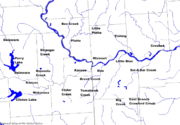
Fishing River
Encyclopedia

Tributary
A tributary or affluent is a stream or river that flows into a main stem river or a lake. A tributary does not flow directly into a sea or ocean...
of the Missouri River
Missouri River
The Missouri River flows through the central United States, and is a tributary of the Mississippi River. It is the longest river in North America and drains the third largest area, though only the thirteenth largest by discharge. The Missouri's watershed encompasses most of the American Great...
in western Missouri
Missouri
Missouri is a US state located in the Midwestern United States, bordered by Iowa, Illinois, Kentucky, Tennessee, Arkansas, Oklahoma, Kansas and Nebraska. With a 2010 population of 5,988,927, Missouri is the 18th most populous state in the nation and the fifth most populous in the Midwest. It...
in the United States
United States
The United States of America is a federal constitutional republic comprising fifty states and a federal district...
. It rises in the northeastern extremity of Kansas City
Kansas City, Missouri
Kansas City, Missouri is the largest city in the U.S. state of Missouri and is the anchor city of the Kansas City Metropolitan Area, the second largest metropolitan area in Missouri. It encompasses in parts of Jackson, Clay, Cass, and Platte counties...
in Clay County and flows generally eastward and southeastward through Clay and southeastern Ray counties, past the town of Mosby
Mosby, Missouri
Mosby is a city in Clay County, Missouri, United States, along the Fishing River. The population was 242 at the 2000 census.-Geography:Mosby is located at ....
. It joins the Missouri River about 3 miles (5 km) south of the town of Orrick
Orrick, Missouri
Orrick is a town in Ray County, Missouri, United States. The population was 799 at the 2010 census.Orrick now includes what was once the village of Albany Orrick is a town in Ray County, Missouri, United States. The population was 799 at the 2010 census.Orrick now includes what was once the village...
.
Downstream of Mosby, it collects the East Fork Fishing River, which rises at the town of Lawson
Lawson, Missouri
Lawson is a city in Clay and Ray counties in the U.S. state of Missouri. The population was 2,473 at the 2010 census.-Geography:Lawson is located at ....
and flows 20.6 miles (33.2 km) generally southward through Ray and Clay counties, past the town of Excelsior Springs
Excelsior Springs, Missouri
Excelsior Springs is a city in Clay and Ray counties in the U.S. state of Missouri. The population was 11,084 at the 2010 census. It is located approximately northeast of central Kansas City, Missouri.- Geography :...
.
In 1808, William Clark of the Lewis and Clark Expedition
Lewis and Clark Expedition
The Lewis and Clark Expedition, or ″Corps of Discovery Expedition" was the first transcontinental expedition to the Pacific Coast by the United States. Commissioned by President Thomas Jefferson and led by two Virginia-born veterans of Indian wars in the Ohio Valley, Meriwether Lewis and William...
established Fort Osage
Fort Osage
Fort Osage was part of the United States factory trading post system for the Osage Nation in the early 19th century near Sibley, Missouri....
along the Missouri near the mouth of the Fishing River. The fort became a center of trade among European settlers and Native Americans in the region.

